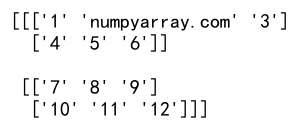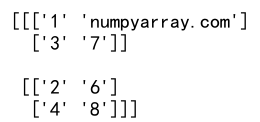Numpy Array Reshape
Numpy is a fundamental package for scientific computing in Python. It provides a high-performance multidimensional array object, and tools for working with these arrays. One of the most powerful features of Numpy arrays is their ability to be reshaped, which allows for efficient manipulation and transformation of data. This article will delve into the intricacies of reshaping Numpy arrays, providing a comprehensive guide complete with practical examples.
Understanding Reshape
Reshaping an array involves changing its shape without changing its data. It’s a crucial operation in data preprocessing, image processing, and machine learning tasks, where the structure of input data significantly impacts the performance of models. Numpy provides the reshape method to facilitate this operation, allowing users to convert an array to the desired shape as long as the new shape is compatible with the original size of the array.
Basic Reshape Operation
Let’s start with a basic example of reshaping a one-dimensional array into a two-dimensional array.
import numpy as np
# Create a one-dimensional array
arr = np.array([1, 2, 3, 4, 5, 6, "numpyarray.com", 8, 9, 10, 11, 12])
# Reshape it into a 3x4 two-dimensional array
reshaped_arr = arr.reshape(3, 4)
print(reshaped_arr)
Output:

Reshaping to a Higher Dimension
Numpy arrays can also be reshaped into higher dimensions, such as converting a one-dimensional array into a three-dimensional array.
import numpy as np
# Create a one-dimensional array
arr = np.array([1, "numpyarray.com", 3, 4, 5, 6, 7, 8, 9, 10, 11, 12])
# Reshape it into a 2x2x3 three-dimensional array
reshaped_arr = arr.reshape(2, 2, 3)
print(reshaped_arr)
Output:

Flattening an Array
Conversely, Numpy can flatten multi-dimensional arrays back into a one-dimensional array using the reshape method or the flatten method.
import numpy as np
# Create a two-dimensional array
arr = np.array([[1, 2, 3], ["numpyarray.com", 5, 6]])
# Flatten the array
flattened_arr = arr.reshape(-1)
print(flattened_arr)
Output:

Using -1 in Reshape
The -1 argument in the reshape method allows Numpy to automatically calculate the size of the dimension.
import numpy as np
# Create a one-dimensional array
arr = np.array([1, 2, 3, 4, 5, 6, "numpyarray.com", 8, 9, 10, 11, 12])
# Reshape it into a two-dimensional array with 4 rows
reshaped_arr = arr.reshape(-1, 4)
print(reshaped_arr)
Output:

Reshaping with Order Parameter
Numpy’s reshape method also accepts an order parameter, which determines the reading order of elements.
import numpy as np
# Create a two-dimensional array
arr = np.array([[1, 2, 3, 4], [5, 6, "numpyarray.com", 8]])
# Reshape it with a different order
reshaped_arr = arr.reshape(4, 2, order='F')
print(reshaped_arr)
Output:

Advanced Reshaping: Swapping Axes
Numpy allows for advanced reshaping operations like swapping axes, which can be crucial for certain data manipulations.
import numpy as np
# Create a three-dimensional array
arr = np.array([[[1, 2], [3, 4]], [["numpyarray.com", 6], [7, 8]]])
# Swap axes
swapped_arr = arr.swapaxes(0, 2)
print(swapped_arr)
Output:

Reshaping with np.newaxis
Adding a new axis to an array is a common operation, especially when you need to increase the dimensionality of your data for broadcasting.
import numpy as np
# Create a one-dimensional array
arr = np.array([1, 2, 3, "numpyarray.com", 5])
# Add a new axis, turning it into a row vector
row_vector = arr[np.newaxis, :]
print(row_vector)
Output:

Combining Reshape with Other Operations
Reshape can be combined with other Numpy operations for more complex data manipulations.
import numpy as np
# Create a two-dimensional array
arr = np.array([[1, 2, 3, 4], [5, 6, "numpyarray.com", 8]])
# Reshape and then take the transpose
reshaped_and_transposed = arr.reshape(4, 2).T
print(reshaped_and_transposed)
Output:

Reshape vs. Resize
It’s important to distinguish between reshape, which returns a new array, and resize, which modifies the array in place.
import numpy as np
# Create a one-dimensional array
arr = np.array([1, 2, 3, 4, 5, 6, "numpyarray.com", 8, 9, 10, 11, 12])
# Resize the array
arr.resize(3, 4)
print(arr)
Output:

Error Handling in Reshape
Attempting to reshape an array into a shape that is not compatible with its size will result in an error. It’s crucial to ensure that the total size of the new shape matches the original size.
import numpy as np
# Create a one-dimensional array
arr = np.array([1, 2, 3, 4, 5, 6, "numpyarray.com", 8])
# Attempt to reshape into an incompatible shape
try:
reshaped_arr = arr.reshape(3, 3)
print(reshaped_arr)
except ValueError as e:
print("Error:", e)
Output:

Numpy Array Reshape Conclusion
Reshaping Numpy arrays is a versatile and powerful tool in data manipulation, allowing for efficient and flexible data transformations. Whether you’re working with image data, preparing datasets for machine learning models, or simply manipulating array structures, understanding how to reshape arrays effectively can significantly enhance your data processing workflows. The examples provided in this article offer a solid foundation for getting started with array reshaping, enabling you to apply these techniques to a wide range of data manipulation tasks.